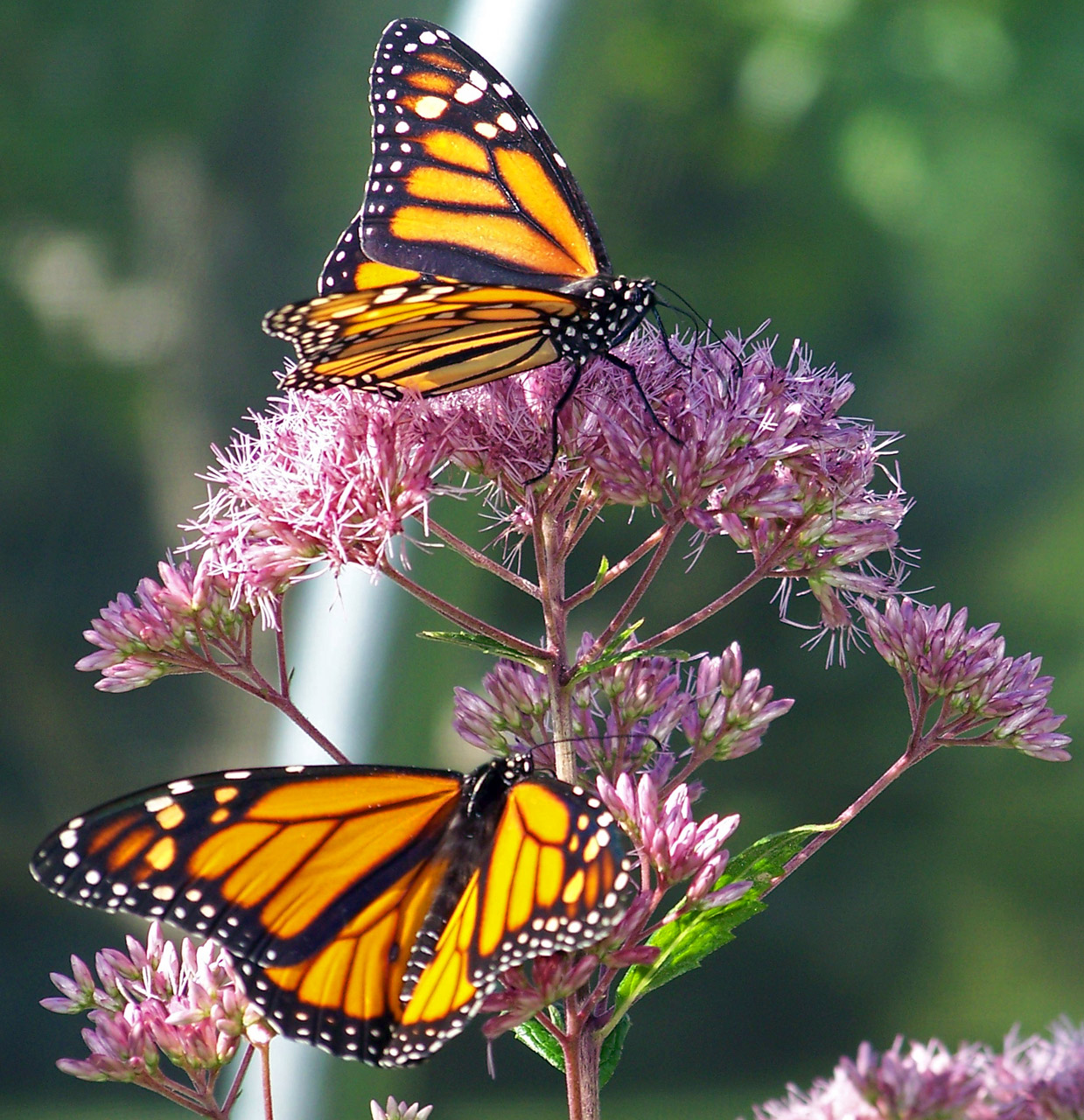Un'altra migrazione che ho sempre considerato estremamente affascinante è quella della farfalla monarca (Danao plexippus). Si tratta di una migrazione di massa che ogni autunno porta milioni di questi straordinari animali a intraprendere un viaggio lungo 4.000 km per spostarsi dalle regioni del Nord America fino in California e in Messico. E' un viaggio che ha uno scopo ben preciso: restare in vita. Devono mettersi in volo ogni autunno prima che arrivi il freddo, che può ucciderli se indugiano troppo. Questi insetti quando giungono a destinazione si riuniscono in gruppi di decine di migliaia di individui e si attaccano ai rami e ai tronchi degli alberi. Secondo uno studio della University of Massachusetts, pubblicata su Current Biology, proprio questo raggruppamento fitto, insieme alla copertura offerta dalla foresta, riuscirebbe a produrre un particolare microambiente in grado di proteggere le farfalle da condizioni ambientali estreme: il freddo sarebbe sufficiente a mantenere basso il loro metabolismo, ma non troppo da provocarne il congelamento. In primavera, l'aumento della temperatura fa scattare il risveglio delle monarche, inducendole a ripercorrere la stessa strada verso il luogo d'origine. Quando poi comincia la migrazione nell'autunno dell'anno successivo si sono già succedute diverse generazioni estive (a causa della breve vita di questo insetto), di conseguenza a mettersi in volo saranno i discendenti dei migratori dell'anno prima. Poi accade qualcosa per me di assolutamente straordinario, ovvero che queste nuove generazioni è come se conoscessero già la strada, ripercorrendo le stesse rotte seguite dai loro antenati, tornando, a volte, addirittura nel medesimo albero.
Recentemente un gruppo di ricercatori dell'Università di Washington, in un articolo pubblicato sulla rivista Cell Reports, è riuscito a spiegare come questi piccoli ma tenaci animali riescano ad orientarsi e arrivare ogni anno dal Canada in California o in Messico. La spiegazione risiede negli occhi e nelle antenne. Gli occhi funzionano come un "sestante" (antico strumento usato dai marinai per tracciare le rotte in base alla disposizione dei corpi celesti rispetto all'orizzonte), in questo modo i neuroni della farfalla riescono a individuare la posizione del Sole rispetto all'orizzonte (riuscendo così a capire dove si trova il nord). Le antenne invece funzionano come un orologio naturale, anch'esso basato sul Sole. Bene, è proprio grazie a questi due strumenti che questi insetti hanno la capacità di orientarsi in relazione al tempo e alla posizione del Sole.
Nel precedente post ho riportato l'esempio della sterna codalunga (Sterna paradisaea) e ora quello della farfalla monarca (Danao plexippus), ma avrei potuto raccontarvi della tartaruga marina (Caretta caretta) e di tante altre specie, in quanto sono numerose quelle che migrano. Sono tutte specie, a mio avviso, estremamente affascinanti e che non possono non suscitare profonda ammirazione per la tenacia e costanza che mettono ogni anno nei loro spostamenti. Si tratta di una vita davvero molto movimentata e attiva, che ha un unico grande scopo: la sopravvivenza.
Another migration that I have always considered extremely fascinating is that of the monarch butterfly (Danaus plexippus). It is a mass migration that brings each autumn millions of these extraordinary animals to make a journey of 4000 km to move from the regions of North America to California and Mexico. It's a journey that has a very specific purpose: to stay alive. They must get in flight every autumn before it gets cold, that can kill them if they linger too. These insects when they arrive at their destination, they gather in groups of tens of thousands of individuals and attach themselves to the branches and trunks of trees.
According to a study by the University of Massachusetts, published in Current Biology, this dense grouping, with the coverage offered by the forest, it would be able to produce a particular microenvironment that it can protect butterflies from extreme environmental conditions: the cold would be enough to keep down their metabolism, but not too much to cause freezing.
In spring, the temperature increase causes the awakening of monarchs, inducing them to retrace the same road to the place of origin. When the migration begins in the autumn of the following year, it has already occurred some summer generations (because of the short life of this insect), therefore to put in flight will be the descendants of migratory of the year before. Then happens something of extraordinary for me, that is these new generation is as if they already knew the way, and retrace the same route followed by their ancestors, going back, sometimes, even in the same tree.
Recently a group of researchers at the University of Washington, in an article published in the journal "Cell Reports", was able to explain how these small and tenacious animals can orient themselves and arriving each year from Canada to California or Mexico. The explanation is situated in the eyes and antennae. The eyes functions like a "sextant" (ancient instrument used by sailors to trace the routes based on the arrangement of celestial bodies relative to the horizon), in this way the butterfly neurons are able to locate the position of the sun relative to the horizon (this allows him to locate the north). The antennas instead function as a natural clock, which is also based on the Sun.
Well, these are two tools that allow these insects to orient themselves in relation to time and the position of the sun.
In the previous post I reported the example of the arctic tern (Sterna paradisaea), and now the monarch butterfly (Danaus plexippus), but I could tell you about the sea turtle (Caretta caretta) and many other species, because are numerous those that migrate . All species are, in my opinion, extremely fascinating and generates deep admiration for the tenacity and constancy that put every year in their movements. It is a very busy and active life, which has one great purpose: survival.

